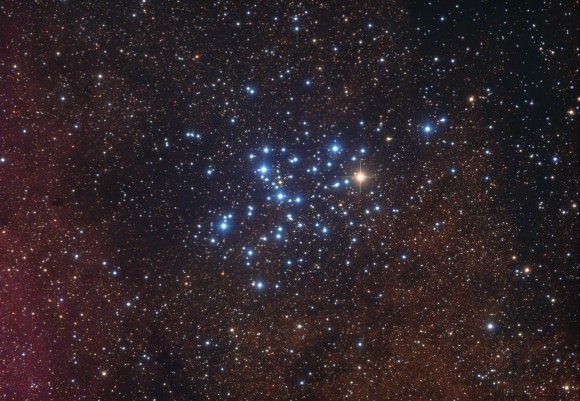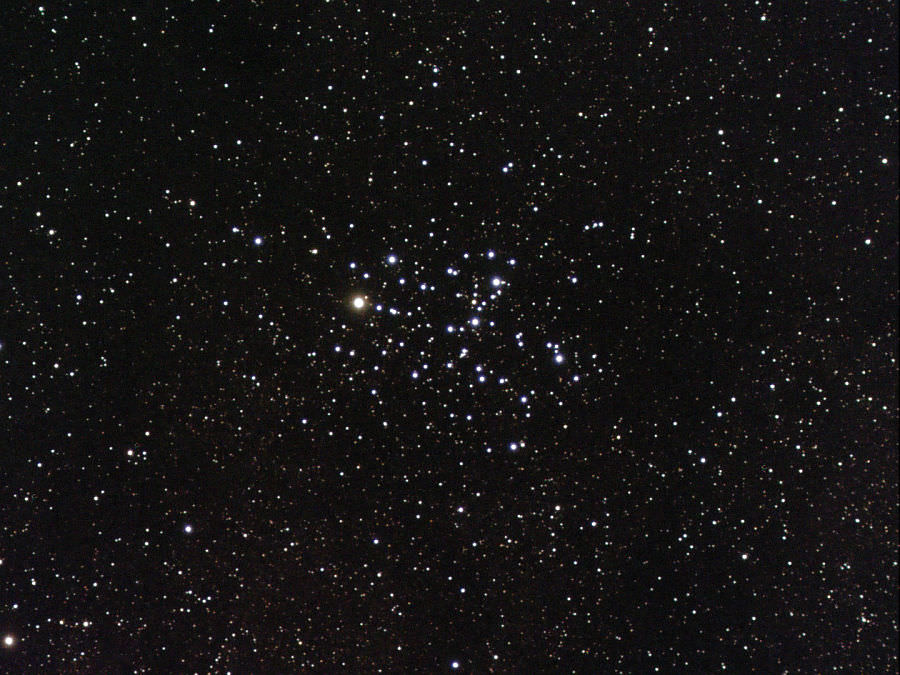Welcome back to Messier Monday! We continue our tribute to our dear friend, Tammy Plotner, by looking at Messier 6, otherwise known as NGC 6405 and the Butterfly Cluster. Enjoy!
In the late 18th century, Charles Messier was busy hunting for comets in the night sky, and noticed several “nebulous” objects. After initially mistaking them for the comets he was seeking, he began to compile a list of these objects so other astronomers would not make the same mistake. Known as the Messier Catalog, this list consists of 100 objects, consisting of distant galaxies, nebulae, and star clusters.
This Catalog would go on to become a major milestone in the history of astronomy, as well as the study of Deep Sky Objects. Among the many famous objects in this catalog is M6 (aka. NGC 6405), an open cluster of stars in the constellation of Scorpius. Because of its vague resemblance to a butterfly, it is known as the Butterfly Cluster.
Description:
Located in the Scorpius constellation, M6 is situated at the closest angular distance of any Messier Object from the Galactic Center – which is located in the constellation Sagittarius, but near to the 3-constellation edge of Sagittarius, Scorpius and Ophiuchus. Estimates of the Butterfly Cluster’s distance have varied over the years, which average out to an estimate of about 1,600 light-years.

The 80 stars that make up M6 are all moving through space together in an area spanning about 12 to 25 light years across – and may have formed anywhere from 51 to 95 million years ago. The brightest of its stars is a variable known as BM Scorpii, a yellow or orange supergiant that changes its magnitude between 5.5 and 7 with a semi-regular period. However, most of the stars here are hot, blue main sequence stars of spectral type B4-B5.
Members of this group were formed in the same giant molecular cloud and are still loosely bound to each other. Studies have been conducted on Messier 6’s upper main sequence stars for strong, highly structured magnetic fields – leading researchers further into understanding the origins and evolution of Ap stars in open clusters.
History of Observation:
It is commonly believed that the first astronomer to record the Butterfly Cluster’s position in the sky was Giovanni Battista Hodierna in 1654. However, Robert Burnham, Jr. has suggested in the “Celestial Handbook” that Ptolemy may have seen it while noting the Ptolemy Cluster (M7). While Hodierna had it on record, it was independently discovered yet again by Philippe Loys de Cheseaux in 1745-46, and was the first to recognize it as “a very fine star cluster.”
Nicholas Lacaille also included it in his catalog of 1751-52 as Lac III.12 and it was recovered once again by Charles Messier on on May 23rd, 1764. A he recorded in his notes on the occasion:
“In the same night of May 23 to 24, 1764, I have determined the position of a cluster of small stars between the bow of Sagittarius and the tail of Scorpius: At simple view [with the naked eye], this cluster appears to form a nebula without stars, but the slightest instrument which one employs to examine it makes one see that it is nothing but a cluster of small stars. Lacaille has it.”

However, it was Robert Burnham Jr. who is credited with giving the nebula it’s nickname. As he described it in his “Celestial Handbook”: “The present author regards this as one of the most attractive clusters in the heavens for small instruments, a completely charming group whose arrangement suggests the outline of a butterfly with open wings.”
Locating Messier 6:
One of the easiest ways to find the “Butterfly Cluster” is to recognize the two familiar constellation asterisms of Scorpius and Sagittarius. The bright star the represents the ‘stinger’ on the tail of the Scorpion is Lambda. Aim your binoculars three fingerwidths northeast. Under dark skies it will show as a hazy patch in the sky, but do not confuse it with its brighter, southeastern neighbor, M7. In binoculars, Messier 6 stars will all appear to be around the same brightness and the ‘butterfly’ asterism will be unmistakable.
In a telescope, many more stars will be revealed – making the namesake a bit harder to recognize, but more interesting because more stars are seen and color is distinguished. However, watch this cluster on nights when there is a little fine cloud in the sky or moonlight. You’ll see the shape in a telescope quite clearly then! Be sure to stay a minimum magnification when using a telescope, because this is a large open star cluster.
And for your convenience, here are the quick facts about M6:
Object Name: Messier 6
Alternative Designations: M6, NGC 6405, Lac III.12, Butterfly Cluster
Object Type: Type “E” Open Star Cluster
Constellation: Scorpius
Right Ascension: 17 : 40.1 (h:m)
Declination: -32 : 13 (deg:m)
Distance: 1.6 (kly)
Visual Brightness: 4.2 (mag)
Apparent Dimension: 25.0 (arc min)
Enjoy your stargazing!
We have written many interesting articles about Messier Objects here at Universe Today. Here’s Tammy Plotner’s Introduction to the Messier Objects, M1 – The Crab Nebula, and David Dickison’s articles on the 2013 and 2014 Messier Marathons.
Be to sure to check out our complete Messier Catalog. And for more information, check out the SEDS Messier Database.

